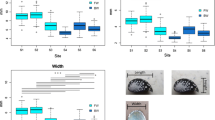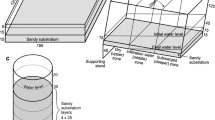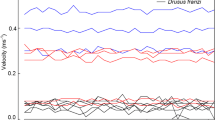Abstract
Tolerance to freezing was measured in four species of hydrobiid snails exposed to temperatures from 0° to-8°C and salinities from 0 to 30‰ S four up to 7 d. Experiments showed the following increasing order of tolerance to freezing: Potamopyrgus jenkinsi (Smith), Hydrobia neglecta Muus, H. ulvae (Pennant) and H. ventrosa (Montagu). Survival decreased with increasing salinity in P. jenkinsi, while the opposite was found in Hydrobia species. H. ulvae survived only slightly better than H. neglecta, while H. ventrosa was very tolerant to freezing even at low salinities in contrast to the other species of Hydrobia. H. neglecta suffered higher winter mortality than H. ventrosa during the severe winter of 1985 in an estuary.
Similar content being viewed by others
Literature cited
Fenchel, T.: Factors determining the distribution patterns of mud snails (Hydrobiidae). Oecologia 20, 1–17 (1975)
Fenchel, T. and L. H. Kofoed: Evidence for exploitative interspecific competition in mud snails (Hydrobiidae). Oikos 27, 367–376 (1976)
Hylleberg, J.: The effect of salinity and temperature on egestion in mud snails (Gastropoda: Hydrobiidae). Oecologia 21, 279–289 (1975)
Hylleberg, J.: Resource partitioning on basis of hydrolytic enzymes in deposit-feeding mud snails (Hydrobiidae). Oecologia 23, 115–125 (1976)
Hylleberg, J.: Distribution of hydrobiid snails in relation to salinity, with emphasis on shell size and co-existence of the species. Ophelia Suppl. 4, 85–100 (1986)
Jensen, K. T. and H. R. Siegismund: The importance of diatoms and bacteria in the diet of Hydrobia species. Ophelia (Suppl.) 1, 193–199 (1980)
Kofoed, L. H.: The feeding biology of Hydrobia ventrosa (Montagu). I. The assimilation of different components of the food. J. exp. mar. Biol. Ecol 19, 233–241 (1975)
Lassen, H. H. and M. Clark: Comparative fecundity in three Danish mud snails (Hydrobiidae). Ophelia 18, 171–178 (1979)
Lassen, H. H. and J. H. Kristensen: Tolerance to abiotic factors in mud snails (Hydrobiidae). Nat. Jutl. 20, 243–250 (1978)
Lopez, G. R. and J. S. Levinton: The availability of microorganisms attached to sediment particles as food for Hydrobia ventrosa (Montagu) (Gastropoda: Prosobranchia). Oecologia 32, 263–275 (1978)
Muus, B. J.: The fauna of Danish estuaries and lagoons. Medd. Danm. Fisk. Havunders., N.S. 5, 1–316 (1967)
Reise, K.: Tidal flat ecology. An experimental approach to species interactions. Ecological Studies 54, 191 pp. Berlin: Springer Verlag 1985
Siegismund, H. R. and J. Hylleberg: Dispersal-mediated coexistence of mud snails (Hydrobiidae) in an estuary. Mar. Biol. 94, 395–402 (1987)
Author information
Authors and Affiliations
Additional information
Communicated by T. Fenchel, Aarhus
Rights and permissions
About this article
Cite this article
Hylleberg, J., Siegismund, H.R. Niche overlap in mud snails (hydrobiidae): freezing tolerance. Mar. Biol. 94, 403–407 (1987). https://doi.org/10.1007/BF00428246
Accepted:
Published:
Issue Date:
DOI: https://doi.org/10.1007/BF00428246




